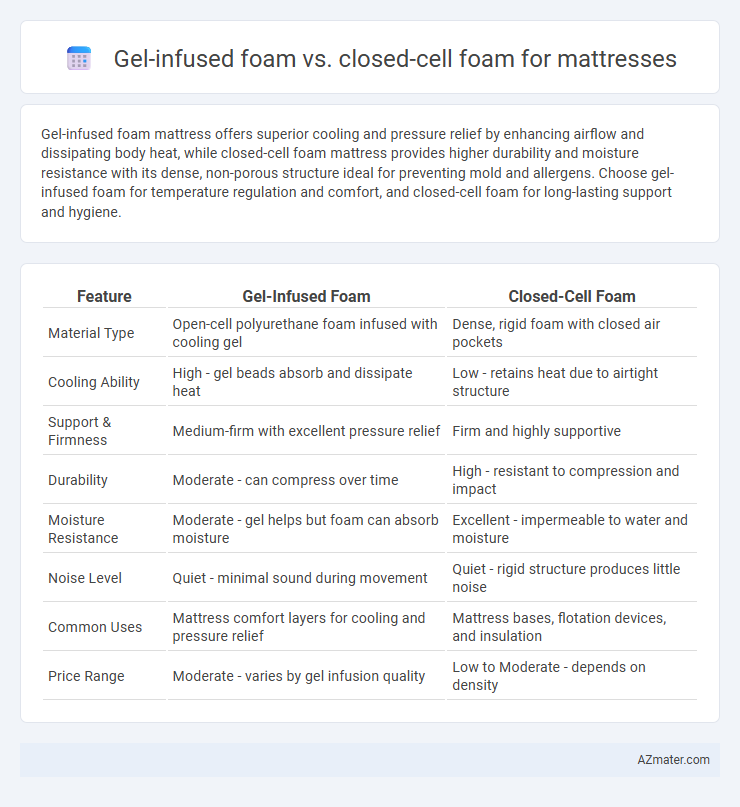Gel-infused foam mattress offers superior cooling and pressure relief by enhancing airflow and dissipating body heat, while closed-cell foam mattress provides higher durability and moisture resistance with its dense, non-porous structure ideal for preventing mold and allergens. Choose gel-infused foam for temperature regulation and comfort, and closed-cell foam for long-lasting support and hygiene.
Table of Comparison
| Feature | Gel-Infused Foam | Closed-Cell Foam |
|---|---|---|
| Material Type | Open-cell polyurethane foam infused with cooling gel | Dense, rigid foam with closed air pockets |
| Cooling Ability | High - gel beads absorb and dissipate heat | Low - retains heat due to airtight structure |
| Support & Firmness | Medium-firm with excellent pressure relief | Firm and highly supportive |
| Durability | Moderate - can compress over time | High - resistant to compression and impact |
| Moisture Resistance | Moderate - gel helps but foam can absorb moisture | Excellent - impermeable to water and moisture |
| Noise Level | Quiet - minimal sound during movement | Quiet - rigid structure produces little noise |
| Common Uses | Mattress comfort layers for cooling and pressure relief | Mattress bases, flotation devices, and insulation |
| Price Range | Moderate - varies by gel infusion quality | Low to Moderate - depends on density |
Introduction to Gel-Infused Foam and Closed-Cell Foam Mattresses
Gel-infused foam mattresses incorporate gel beads that enhance cooling and airflow, addressing heat retention issues common in traditional foams. Closed-cell foam, characterized by dense, air-tight cells, offers superior durability and moisture resistance, making it ideal for firm support and longevity. Both materials cater to specific sleep preferences, with gel-infused foam excelling in temperature regulation and closed-cell foam providing enhanced structural integrity.
Material Composition: Gel-Infused vs Closed-Cell Foam
Gel-infused foam consists of polyurethane foam embedded with gel beads or swirls designed to enhance breathability and regulate temperature, offering a cooler sleeping surface. Closed-cell foam is composed of tightly packed, dense cells that create a rigid, moisture-resistant structure, providing superior durability and support but less airflow. The material composition of gel-infused foam prioritizes temperature regulation and softness, while closed-cell foam emphasizes structural integrity and moisture resistance for mattress applications.
Comfort and Support Comparison
Gel-infused foam mattresses excel in temperature regulation and pressure relief, providing enhanced comfort by dissipating heat and contouring to the body. Closed-cell foam offers superior support due to its dense, rigid structure, maintaining spinal alignment and durability under consistent weight. For optimal comfort and support balance, gel-infused foam is preferred by sleepers seeking cooling softness, while closed-cell foam suits those requiring firm, long-lasting mattress support.
Temperature Regulation and Cooling Properties
Gel-infused foam mattress toppers enhance temperature regulation by incorporating gel beads that absorb and dissipate heat, providing a cooler sleeping surface compared to traditional foams. Closed-cell foam, due to its dense structure, tends to trap heat and restrict airflow, resulting in less effective cooling properties. Choosing gel-infused foam improves breathability and mitigates heat retention, optimizing comfort for hot sleepers.
Durability and Longevity
Gel-infused foam mattresses provide enhanced durability through their ability to resist body impressions and maintain structural integrity over time, making them ideal for users seeking long-lasting comfort. Closed-cell foam offers superior longevity due to its dense, rigid structure that resists moisture absorption and microbial growth, which preserves mattress quality and extends its lifespan. When comparing durability, gel-infused foam excels in heat dissipation and pressure relief while closed-cell foam dominates in resistance to environmental wear and structural breakdown.
Motion Isolation and Noise Reduction
Gel-infused foam mattresses excel in motion isolation by contouring to the body and absorbing movement, minimizing disturbance between sleep partners. Closed-cell foam offers superior noise reduction due to its dense, airtight structure that prevents sound transmission. Both materials reduce motion transfer and noise, but gel-infused foam provides enhanced breathability alongside effective motion isolation, while closed-cell foam delivers exceptional soundproofing with firmer support.
Allergen Resistance and Health Factors
Gel-infused foam mattresses offer enhanced allergen resistance due to their open-cell structure, which promotes better airflow and reduces moisture buildup that can harbor dust mites and mold. Closed-cell foam, while denser and more durable, tends to trap heat and moisture, potentially increasing the risk of allergen accumulation and respiratory irritants. For health-conscious sleepers, gel-infused foam provides a cooler, hypoallergenic sleep environment that supports respiratory wellness and reduces allergy triggers.
Price Differences and Value Analysis
Gel-infused foam mattresses typically cost 10% to 20% more than closed-cell foam mattresses due to their enhanced cooling properties and pressure relief benefits. Closed-cell foam offers higher durability and moisture resistance, making it a cost-effective choice for budget-conscious consumers seeking longevity. Evaluating value, gel-infused foam delivers superior temperature regulation, which justifies the premium price for those prioritizing comfort and heat dissipation.
Ideal Sleepers for Each Foam Type
Gel-infused foam mattresses are ideal for hot sleepers and those seeking pressure relief due to their enhanced cooling properties and contouring support. Closed-cell foam mattresses suit individuals who prefer firmer support and durability, making them better for back and stomach sleepers requiring spinal alignment. Weight distribution and sleep posture play crucial roles in selecting between gel-infused and closed-cell foam options for optimal comfort.
Final Verdict: Which Foam Mattress Should You Choose?
Gel-infused foam mattresses offer enhanced temperature regulation and pressure relief, making them ideal for hot sleepers seeking comfort and cooling effects. Closed-cell foam provides superior durability, firmer support, and moisture resistance, suitable for those requiring a more robust, long-lasting mattress. Choose gel-infused foam for a cooler, softer sleep experience, while closed-cell foam is better for support and longevity in diverse environments.

Infographic: Gel-infused foam vs Closed-cell foam for Mattress
 azmater.com
azmater.com